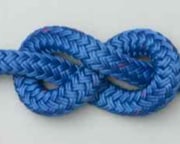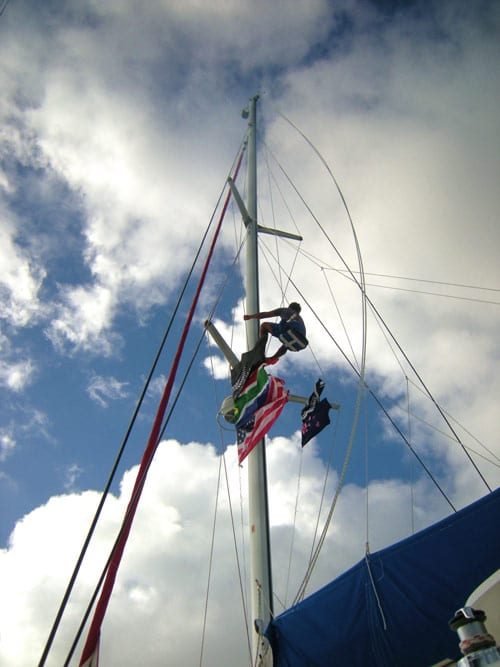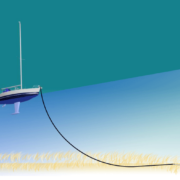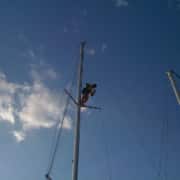A Stopper Knot in Time Saves…
Whether you’re learning to sail or are an advanced sailor, this tip is a really good one. It’s basic stuff for any competent crew course but you’ll see the value pretty quickly, especially if you don’t like going up the mast.
Recently on our NauticEd flotilla to Tonga with Moorings, I semi embarrassingly re-learned a valuable lesson and that’s the value of a stopper knot.
A stopper knot, of course, is a knot at the end of a halyard or jib sheet that will prevent the line from pulling through fairleads etc and always keeps your line accessible in its proper place. It’s tied in such a manner that you can get it undone – as opposed to the definition of a knife knot which means you need a knife to undo it. And on a sailboat the old saying of “if you can’t tie a knot tie a lot” doesn’t really work).
Here’s how to tie a figure 8 stopper knot. And what’s cool about this site is that they have an iPhone app you can download so you can carry your knots with you.
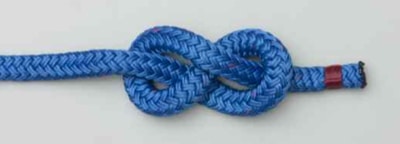 a Figure 8 Stopper Knot
a Figure 8 Stopper Knot
Stopper Knot Lesson Learned
Sailing Flotilla to Vav’a, The Kingdom of Tonga: with all the excitement of Tonga and the flotilla and sailing a really nice 47-foot Catamaran chartered from the Moorings in Vava’U Tonga, I neglected to do the walk around to ensure that every appropriate line had a stopper knot at the end.
The result? No so good. At the end of the first day I pulled down the sail and tookt he halyard connected to the head of the mainsail and wraped it under a cleat at the base of the mast. I do this as standard operating procedure so that the sail can not get lifted back up during the night should a big wind come through. Well unfortunately, the halyard was designed to be long enough to accommodate this extra precaution and the end of the halyard disappeared up into the mast. Opps!
I just stood there looking at it going “ok that’s not good” and wondering how I was going to keep it a secret. Not possible. My call back to the Moorings Base was heard by the other captains in the flotilla and so I was instantly awarded the first blue duck of the sailing trip.
A blue duck award is a sailing faux pas certificate that is handed out to captains who make such silly mistakes and has become a tradition on the flotillas I run. It’s kinda like a yellow card in soccer but not that bad.
So fortunately the Moorings Base people were extremely understanding and sent out a chase boat. We all stood around wondering what trick they have up their sleeves to fix this interesting problem.
Well no trick really, we winched one of them up the mast who pushed the halyard back down inside the mast, then the other poked a piece of bent wire into the hole in the mast from when the halyard is supposed to come out. He hooked the wire in behind the halyard. However strangely enough the hole is too small for a doubled over halyard to come out and so the top o’ the mast guy had to slowly pull up the halyard until the bottom o’ the mast guy could see the end. Then with the wire still hooked behind the halyard, he pulled it out the hole in the mast. It was a pretty intricate operation and one that would certainly be impossible in rough seas. Just imagine that, hoisting someone up the mast in a storm and intricately retrieving the halyard all because you didn’t check for a stopper knot! I’m hoping this blog report will help you not have to do that.
Moral of the story? Check your stopper knots and if I operated a charter company (as I used to do) I would sew a small stitch to lock in a stopper knot into essential lines. When you do this however make sure that it’s not a line where you will need to get the knot out quickly in an emergency situation.
BIG NOTE: Don’t put stopper knots in spinnaker sheets and guys. These lines need to be dumped out fast in the likely event of a broach.
###

